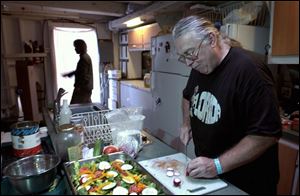
Cooks fuel the crews with seaworthy fare
7/20/2003
Ralph McCutcheon, the cook aboard the HMS Bounty, said he lashes pots and pans to the back of the stove when the ship is at sea. Kitchen demands vary from vessel to vessel.
Whether they're making dal godi masala for 100 in a restaurant-style kitchen or egg rolls for 24 in an apartment-style kitchen, the cooks on the tall ships face similar challenges.
“It's the most demanding job on board,” said Rick Moore, a crew member on the Caledonia.
The hours are long, the galleys are hot and cramped, the crew doesn't always appreciate them, and they encounter problems that never would occur to land-dwelling cooks.
“That thing moves,” said HMS Bounty cook Ralph McCutcheon, pointing at the stove. When the ship is at sea, he lashes pots to hooks on the back of the stove.
Cauldrons have to be extra-large so soup doesn't slosh out, and if the ship rocks too much, bread won't rise, said Brigitte Savard on the Caledonia.
On the Indian navy ship INS Tarangini, the cooks said the rough sea sometimes makes them dance or ski across the galley floor.
Baked goods will set crooked if the ship is heeling to one side. Mr. McCutcheon keeps a C-clamp in his oven “so I can get a semblance of level.”
He's had brownies that ended up thick and chewy on one side and thin and crunchy on the other, he said.
The equipment in the galleys and the number of cooks varies from ship to ship.
The Caledonia's crew, around 20 people, has been taking turns doing the cooking in a temporary galley with a stove and a microwave. Their new cook, hired on Friday, eventually will work in a galley equipped to serve 90 people, Ms. Savard said.
On the INS Tarangini, built in 1997, three cooks at a time crowd into a galley that looks like a tiny restaurant kitchen, with stainless-steel stoves, deep fryer, and dal grinder. One cook chops, one fries, and the third mans the stove, they said.
They serve Chinese food one day a week, but mostly serve a wide variety of Indian food from a six-inch stack of color-coded recipe cards. On Friday, they made chicken kashmiri masala, mixed vegetable kashmiri masala, dal godi masala, vegetable kurmai, and fruit custard.
The four cooks take turns working from 5 a.m. to 9 p.m., said Subhash Chendekar, senior cook.
On the HMS Bounty, built in 1960, Mr. McCutcheon works from 5:30 a.m. to 7 p.m. when the ship is under way. At shore he's “a little better off,” not starting until 8 a.m. He takes an hour-long nap in the afternoon.
Although the crew members do their own dishes and also wash the pots and pans, he has no help with the cooking.
“Where would I put them?” he said.
With counters on both sides of a narrow aisle, he said he would constantly bump into any assistant. The HMS Bounty's galley, which has a normal-sized double sink and electric stove with oven, would not look out of place in an apartment, although it has extra storage and counter space.
“It's a little hairy trying to serve 24 people off a four-burner stove,” he said.
So far he hasn't run across anything he can't make. He makes egg rolls, deep-fries, and once made 300 chicken wings.
“I don't think I've tried a souffl ,” he said.
The crew gets a hot breakfast every other morning, and lunches are typically sandwiches or soup. Friday's lunch included homemade salsa, and he planned chicken thighs for dinner, he said.
Cooking good food from scratch is Mr. McCutcheon's way of keeping the low-paid crew from mutinying.
Yesterday the crews had a chance to try something different - a cookout in the Old West End. Crews in the Huntington Tall Ships Toledo festival, an Ohio Bicentennial Commission Signature Event, were invited to tour three homes in the neighborhood.